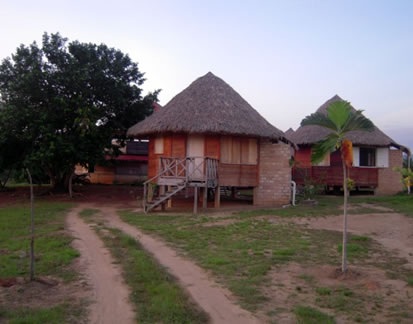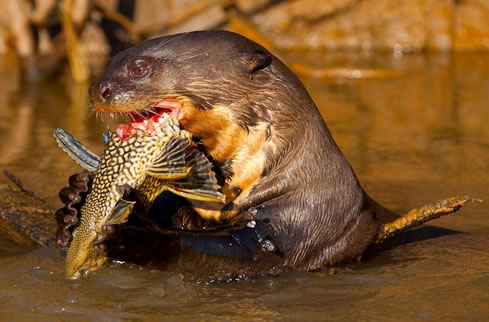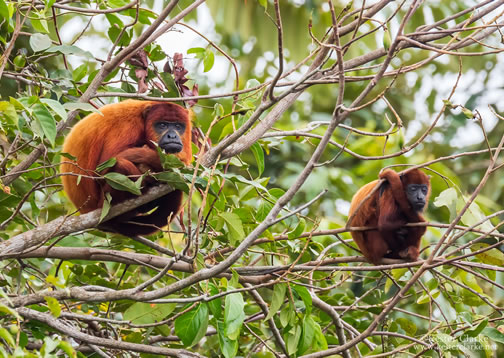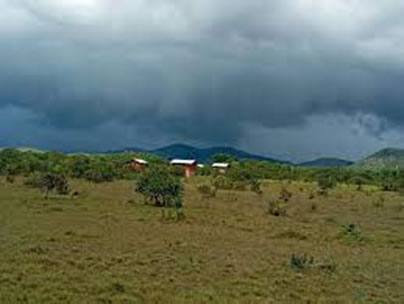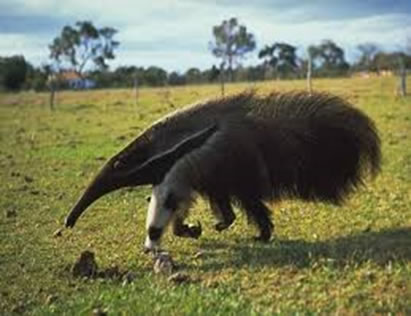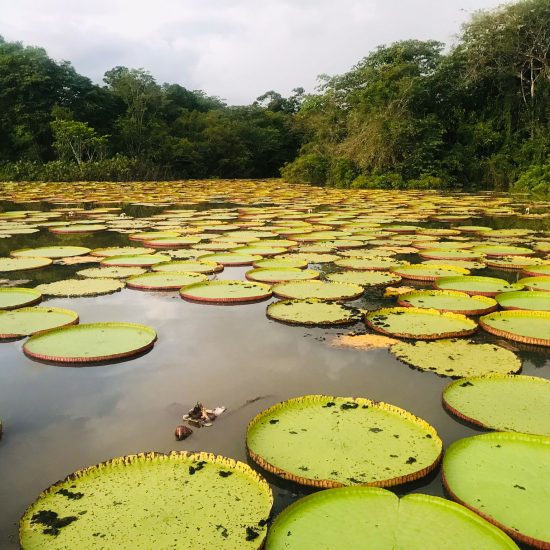Rupununi Highlights
$3490 per person
The Rupununi is a vast are of dry grassland with sparse trees, termite mounds and wooded hills 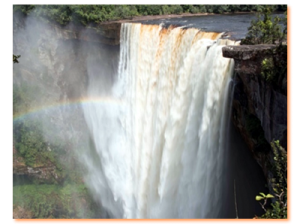 in the Southwest of the country. The savannah is divided into the North and South Rupununi by the Kanuku Mountains and scattered with occasional Amerindian villages and a few large cattle ranches. Rupununi is an area rich in wildlife, particularly rare and endangered species such as the Black Caiman, Giant Otter, Jaguar. Bird life is rich, particularly in the forest galleries, and the Kanuku Mountains provide a home for the Harpy Eagle. So come enjoy the Rugged Rupununi Trails and more!
in the Southwest of the country. The savannah is divided into the North and South Rupununi by the Kanuku Mountains and scattered with occasional Amerindian villages and a few large cattle ranches. Rupununi is an area rich in wildlife, particularly rare and endangered species such as the Black Caiman, Giant Otter, Jaguar. Bird life is rich, particularly in the forest galleries, and the Kanuku Mountains provide a home for the Harpy Eagle. So come enjoy the Rugged Rupununi Trails and more!
Download and print -:- Rupununi Highlights Itinerary.
Minimum Group Size -:- 2 Persons.
Included:
-
- Arrival and departure transfers
- Domestic flights
- All accommodation
- Services of English speaking guides – please note that you will have a different guide in each place on the itinerary, rather than the same guide throughout the trip
- Meals as listed (B – Breakfast, L – Lunch, D – Dinner)
- Entrance fees for sites listed as part of the itinerary
Excluded:
-
- International flights
- Any airport taxes
- Travel Insurance
- Visas
- Drinks
Day 1: Arrival in Guyana & Orientation
Airport  transfer to Georgetown: Overnight Hotel Sleep Inn International Hotel or Equivalent
transfer to Georgetown: Overnight Hotel Sleep Inn International Hotel or Equivalent
Day 2: Historic Georgetown & Kaieteur Falls
Experience Guyana’s Historic Landmarks, Colonial Architecture dating back to the Seventeenth Century, and its pluralistic, ethnically, racially and religiously diverse peoples, referred to as the “Melting Pot” of the Caribbean. The City tour is mostly by foot and takes between two to three hours: After lunch take a 1 hour flight across Guyana’s pristine rainforest to Kaieteur Falls (World’s Largest Single Drop Water Falls). Kaieteur is nearly five times the height of Niagara Falls. Here we hope to find White-chinned and White-tipped Swifts swirling over the gorge, and the astonishingly colorful Guianan Cock-of-the-Rock; Return to Ogle Airport by aircraft at 17.00 hrs and transfer to Georgetown: Overnight Sleep Inn International Hotel (B).
Guyana’s Historic Landmarks, Colonial Architecture dating back to the Seventeenth Century, and its pluralistic, ethnically, racially and religiously diverse peoples, referred to as the “Melting Pot” of the Caribbean. The City tour is mostly by foot and takes between two to three hours: After lunch take a 1 hour flight across Guyana’s pristine rainforest to Kaieteur Falls (World’s Largest Single Drop Water Falls). Kaieteur is nearly five times the height of Niagara Falls. Here we hope to find White-chinned and White-tipped Swifts swirling over the gorge, and the astonishingly colorful Guianan Cock-of-the-Rock; Return to Ogle Airport by aircraft at 17.00 hrs and transfer to Georgetown: Overnight Sleep Inn International Hotel (B).
Day 3: Lethem, Guyana/Brazil Frontier
Take  mid- morning flight across Guyana’s Pristine Rainforest and the North Rupununi Savannahs, and we arrive at the Guyana/Brazil Border Township of Lethem, located in the Upper Takutu-Upper Essequibo Region of Guyana. Lethem is considered the capital of Region 9 and is a hub linking many of the surrounding Indigenous Villages with Georgetown and Boa Vista, the nearest town in Brazil. The recently commissioned Takutu River Bridge links the two countries and offers greater opportunities for trade and commerce. The town is approximately 280 feet above sea level and has a mixed population of approximately 3,500, with a heavy influence of Brazilian Culture. It is named after Sir Gordon James Lethem, who was the Governor of British Guiana from 1941 to 12 April 1947. This afternoon, we would drive out into the Savannahs to the nearby Macushi Village of Kumu nestled on the foothills of the Kanuku Mountains. Kumu Falls offers a refreshing dip or a natural Jacuzzi before returning to the Hotel for some Brazilian Cuisine: Overnight Adventure Guianas Hotel Toucanna (BLD).
mid- morning flight across Guyana’s Pristine Rainforest and the North Rupununi Savannahs, and we arrive at the Guyana/Brazil Border Township of Lethem, located in the Upper Takutu-Upper Essequibo Region of Guyana. Lethem is considered the capital of Region 9 and is a hub linking many of the surrounding Indigenous Villages with Georgetown and Boa Vista, the nearest town in Brazil. The recently commissioned Takutu River Bridge links the two countries and offers greater opportunities for trade and commerce. The town is approximately 280 feet above sea level and has a mixed population of approximately 3,500, with a heavy influence of Brazilian Culture. It is named after Sir Gordon James Lethem, who was the Governor of British Guiana from 1941 to 12 April 1947. This afternoon, we would drive out into the Savannahs to the nearby Macushi Village of Kumu nestled on the foothills of the Kanuku Mountains. Kumu Falls offers a refreshing dip or a natural Jacuzzi before returning to the Hotel for some Brazilian Cuisine: Overnight Adventure Guianas Hotel Toucanna (BLD).
Day 4: Wichabai Ranch, South Rupununi
 This morning drive out by 4*4 vehicle into the Wild. Considered to be one of the oldest, largest and most isolated ranches in the world, Dadanawa and its sister Ranch, Wichabai sits on approximately 1700 square miles of grass lands in the South Rupununi Region of Guyana, where its 6000+ heads of cattle graze free, roaming the foothills of the Kanuku Monutains, or “Mountains of Life”. The South Rupununi Savanahs and Kanuku Mountains provides, food, shelter, medicine and even spiritual guidance to the Indigenous Tribes- the Wapishanas and Wai Wai that inhabits the South Rupununi. Accommodation is in a typical Ranch –Styled wooden building, offering guests a full view of the Savannahs and Mountains. Experience the local cowboys or Vaqueros work the cattle the same way they have done it for centuries. Take a drive further into the Savannah for a hike up the Totawan Mountain for a panoramic view of the wider savannah: Overnight Wichabai Guest House (BLD).
This morning drive out by 4*4 vehicle into the Wild. Considered to be one of the oldest, largest and most isolated ranches in the world, Dadanawa and its sister Ranch, Wichabai sits on approximately 1700 square miles of grass lands in the South Rupununi Region of Guyana, where its 6000+ heads of cattle graze free, roaming the foothills of the Kanuku Monutains, or “Mountains of Life”. The South Rupununi Savanahs and Kanuku Mountains provides, food, shelter, medicine and even spiritual guidance to the Indigenous Tribes- the Wapishanas and Wai Wai that inhabits the South Rupununi. Accommodation is in a typical Ranch –Styled wooden building, offering guests a full view of the Savannahs and Mountains. Experience the local cowboys or Vaqueros work the cattle the same way they have done it for centuries. Take a drive further into the Savannah for a hike up the Totawan Mountain for a panoramic view of the wider savannah: Overnight Wichabai Guest House (BLD).
Day 5: Savannah Trek in Search of Giant Anteaters;
Set out early in the morning for a Giant Anteater sighting, do some horseback riding and witness the Vaqueros at work roping cattle etc. In the afternoon we return to Lethem and Overnight at Adventure Guianas Hotel (BLD.
Day 6: Yupukari Amerindian Village

After breakfast, we drive north into the Rupununi Savannahs, passing giant anthills onto Yupukari Village. Visitors may have the opportunity to meet local craftspeople, including the furniture builders at Yupukari Crafters, a non-profit venture to create village jobs and generate income to sustain educational development during an introductory tour of the Village. Tonight enjoy a foray on the Rupununi River from Caiman House Field Station. As a guest you have the unique opportunity to support and participate in an ongoing field study of the Black Caiman (melanosuchus niger), the largest member of the alligator family and an endangered species. During periods of high water it is difficult to capture Caiman so you will have another chance to enter the nocturnal world of the Rupununi River and associated gallery forests which offer an experience, and world of wildlife entirely different than those viewed on a day trip. Skilled guides will expertly escort visitors to meet elusive denizens of darkness by outboard powered boats, while interpreting the sights, and sounds of Guyana after dark. Just after darkness settles on the River many creatures emerge such as black caiman (to over 12 feet), spectacled caiman, tree boas, iguanas, frogs, and many fish species( i.e arrawana, piranha). Sleeping birds (kingfishers, small perching birds) nightjars, potoos, Boat-billed Herons and other aquatic birds, bats, (harmless) spiders, insects, moths, and more can be closely approached in way not possible during the hours of light. Less likely, but not rare inclusions for night viewing include possums, tree dwelling rodents, capybara and sleeping monkeys (esp. squirrel monkeys) amongst other mammals. Few nights pass without some unusual offering. Overnight Caiman House (BLD).
Day 7: Surama Amerindian Village
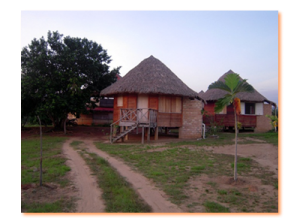
This morning travel out onto the savannah to search for a Giant Anteater, and other wildlife around the environs of the Lodge. Return to the Lodge and depending on the water continue by boat to Ginnip Landing (Alternatively transfer is by vehicle). Explore the gallery forest along the river where we’ll hope to find such species as Spotted Puffbird, Striped Woodcreeper, Pale-bellied Tyrant-Manakin, Golden-spangled Piculet, Bearded Tachuri and Capuchinbird. A feature bird for the area is Agami Heron. The river trip also presents another opportunity to see the wild Giant River Otters, Black Caiman, Arapaima etc whilst being transferred to Surama Amerindian Village. The village of Surama is situated in a small savannah, deep in the rainforest and surrounded by forest clad hills. It was here that Charles Waterton passed through in 1812 in search of the secrets of the useful Wourali poison known as Curare. Waterton was so stunned by this spot that he wrote in his memoirs “The finest park that England boasts falls short of this delightful scene”. Surama’s inhabitants are mainly from the Macushi tribe and still observe many of the traditional practices of their forebears. On our arrival, we will receive a warm welcome from the local people and will be shown to our basic accommodation. Your guide will take you on a tour of the village. As the afternoon cools a local guide will escort you for a short walk on trails to observe the forest and bird life. See the forest through the eyes of your indigenous guide and learn about the medicinal plants and their uses in the Amerindian culture. Tonight enjoy an educational walk to observe wildlife and experience the mystique of the forest after dark. Overnight Surama Eco-Lodge (BLD).
Day 8: Burro Burro River Tour
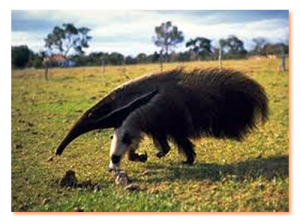
Rise before dawn for a walk across the savannah and then the exhilarating climb up Surama Mountain in the cool morning air. This is the best time to observe bird life along the trail. Breakfast will be served at a lookout point which affords incredible views across the village and savannah to the Pakaraima Mountains. Return to village for lunch and then take a three mile walk across the savannah and through the rainforest to the Burro Burro River. Your guides will then paddle you on the Burro Burro River for opportunities to observe Giant River Otters, Tapir, Tira, Spider Monkeys and many more species. Return to village for sunset. Overnight at Surama Eco Lodge (BLD).
Day 9: Flight to Georgetown
After breakfast return to Lethem for your flight to EF Correia Airport, Ogle and vehicle transfer to Georgetown- Overnight Hotel (B).
Day 10: International Flight
-
-
- Broad rim or peaked sun hat.
- Lightweight, quick dry, light colored long pants and shirts
- Lightweight socks that dry quickly.
- Shorts, bathing suit, T-shirts (ideally light color cotton)
- Slippers or sandals
- Appropriate boots
- Sunscreen and chap stick
- Insect repellent
- Medications for specific personal conditions (for allergic reactions, heart conditions, digestive disturbances, malaria prevention etc.)
- Calamine lotion or sunburn cream
- Sunglasses (ideally with carrying straps)
- Small personal first aid kit (aspirins, small bandages, rubbing alcohol,antibiotic cream, diarrhea medication, gauze pads and rolls of tape insect cream
- Plastic water bottle
- Backpack
- Personal toiletries (toothbrush, paste, soap, small towel, etc.)
- Small flashlight and extra batteries
- Camera, lenses, films, memory card
- Copy Biographic page of Passport
- Requisite Visas (Check with Respective Embassies).
- Yellow Fever Vaccination Card
-






